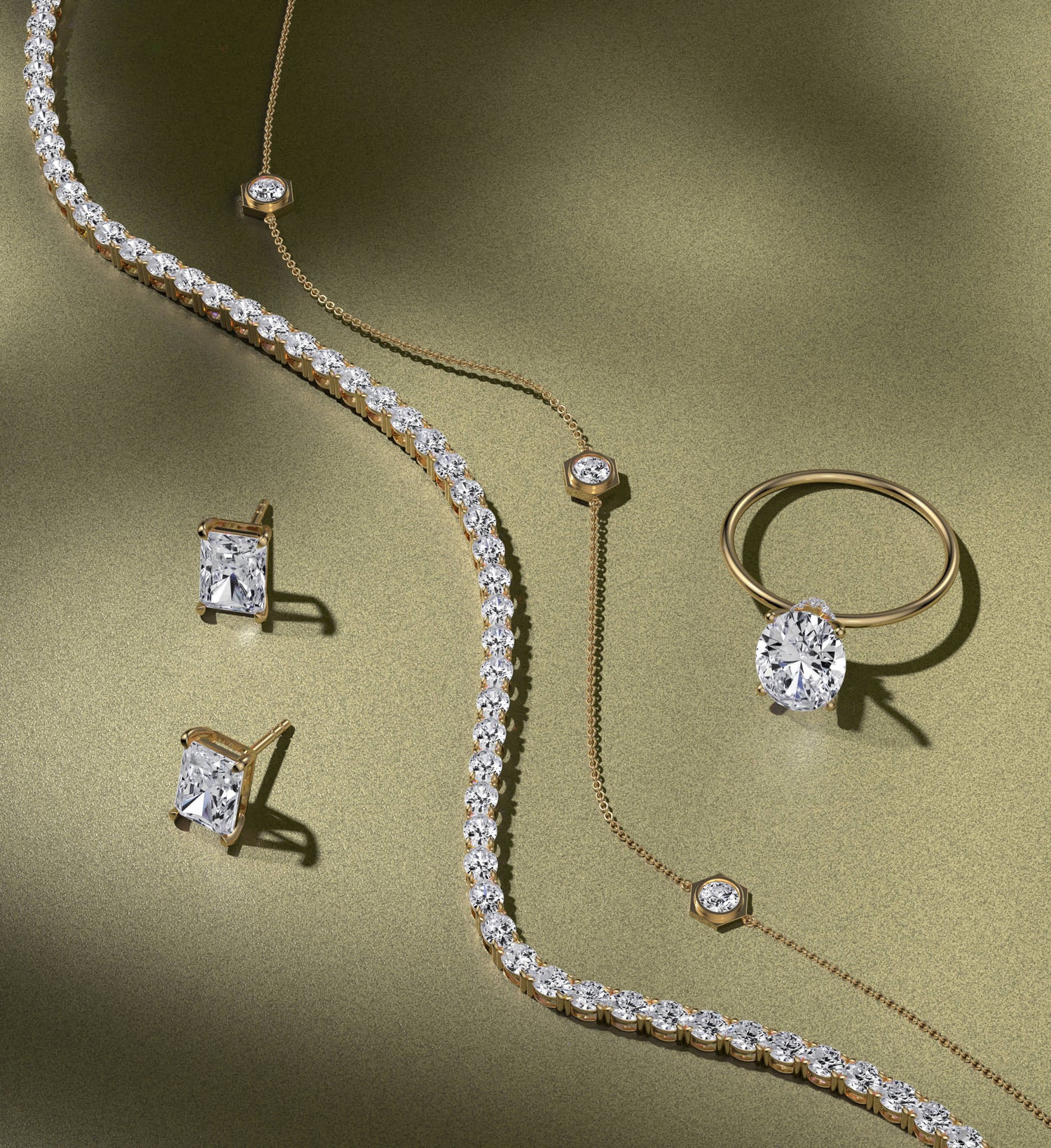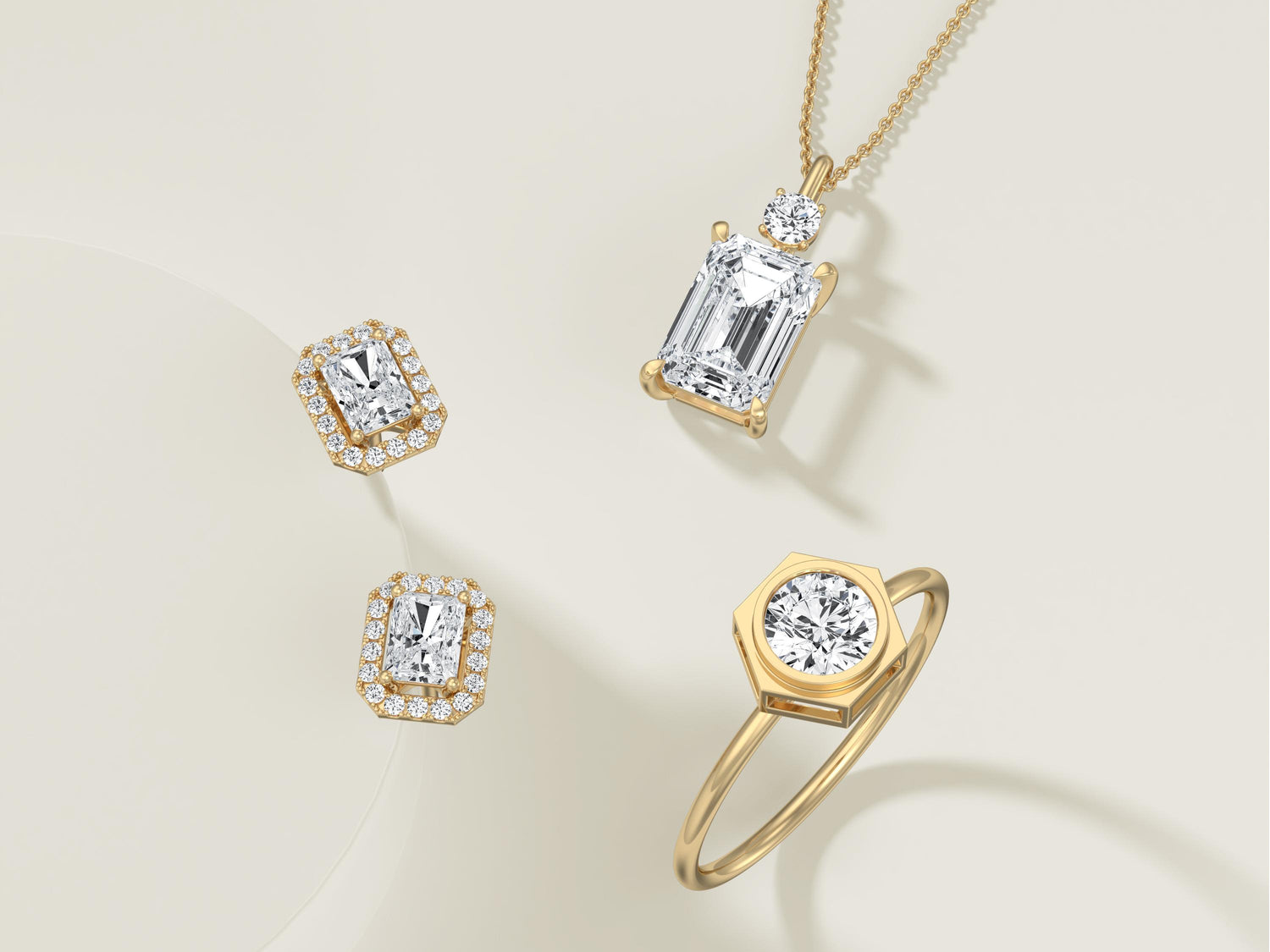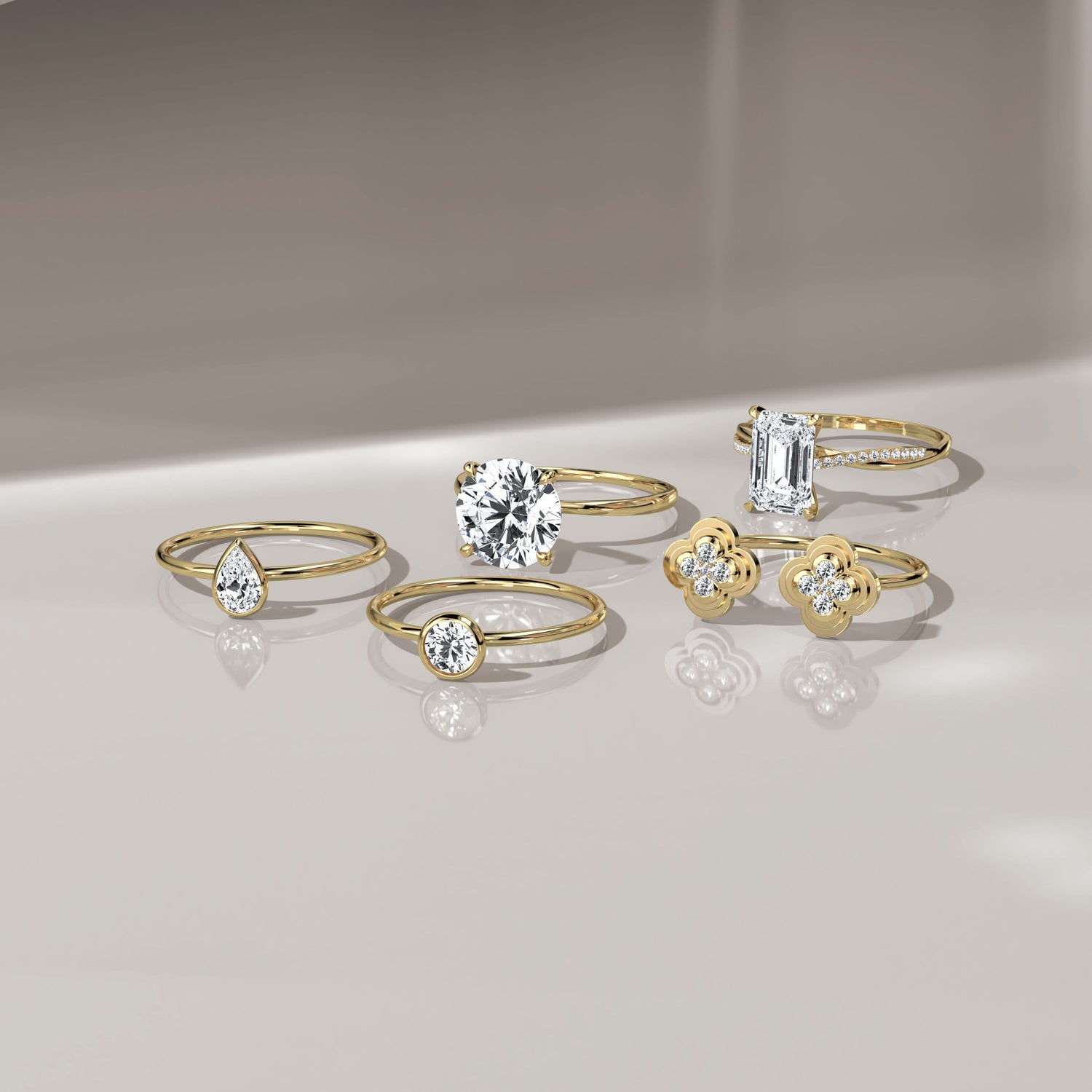IN THIS GUIDE:
- What Are the Diamond 4Cs?
- Cut - The Most Important of the Diamond 4Cs
- Color - The Second Diamond 4Cs Component
- Clarity - The Third Diamond 4Cs Element
- How the 4Cs Work Together
- Avoiding Common 4Cs Mistakes
- Conclusion: Making Smart 4Cs Decisions
What Are the Diamond 4Cs?
The diamond 4Cs are the universal standard for evaluating diamond quality, created by the Gemological Institute of America in the 1940s. Before this system existed, diamond evaluation was subjective and inconsistent.
The diamond 4Cs are:
- Cut: How well the diamond is proportioned and polished
- Color: The absence of color in white diamonds
- Clarity: The absence of inclusions and blemishes
- Carat: The weight of the diamond
These four characteristics determine every diamond's quality, beauty, and value. Understanding how they interact is crucial for making smart purchasing decisions.
Why the Diamond 4Cs Matter for Your Purchase
Each of the diamond 4Cs affects price differently:
- Cut impact: 30-40% of visual appeal, 15-25% of price variation
- Color impact: 15-20% of visual appeal, 15-20% of price variation
- Clarity impact: 10-15% of visual appeal, 20-25% of price variation
- Carat impact: Size perception, 40-50% of price variation
Source: GIA Diamond Quality Assessment Research, 2024
The key insight: carat weight drives price most, but cut quality drives beauty most. Smart buyers balance all four characteristics rather than focusing on just one.
How Diamond 4Cs Grading Works
Professional gemologists evaluate diamonds using:
- Controlled lighting: Standardized light sources for consistency
- 10x magnification: Industry standard for clarity assessment
- Master stones: Reference diamonds for color comparison
- Precision instruments: For measuring proportions and angles
- Trained expertise: Years of experience in diamond evaluation
This scientific approach ensures that a VS2 clarity diamond means the same thing whether graded in New York, Bangkok, or Antwerp.
1. Cut - The Most Important of the Diamond 4Cs
Why Cut Leads the Diamond 4Cs in Importance
Cut is the only one of the diamond 4Cs controlled by human skill rather than nature. A master diamond cutter can transform a rough stone into a brilliant gem, while poor cutting can make even the finest rough material look lifeless.
Cut affects three critical aspects of diamond beauty:
- Brilliance: White light reflection from the diamond
- Fire: Dispersion of light into rainbow colors
- Scintillation: Flashes of light when the diamond moves
Diamond 4Cs Cut Grading Scale
The GIA grades cut quality on five levels:
Excellent Cut:
- Maximum brilliance and fire
- Precise proportions and angles
- Superior polish and symmetry
- Premium pricing (10-15% above Very Good)
Very Good Cut:
- High brilliance with slight light leakage
- Good proportions with minor variations
- Excellent value proposition
- Often indistinguishable from Excellent to untrained eyes
Good Cut:
- Moderate brilliance
- Noticeable light leakage in some areas
- Budget-friendly option
- 15-20% savings over Very Good
Fair Cut:
- Limited brilliance
- Significant light leakage
- Poor value - avoid for engagement rings
Poor Cut:
- Minimal brilliance
- Substantial light leakage
- Only suitable for industrial use
Diamond 4Cs Cut Buying Strategy
Best value approach: Choose Very Good cut quality. The visual difference from Excellent is minimal while saving 10-15%.
Maximum beauty approach: Select Excellent cut with Excellent polish and symmetry for ultimate brilliance.
Budget approach: Good cut can work for smaller diamonds (under 0.75 carats) where cut deficiencies are less noticeable.
Shape considerations: Cut grading currently applies only to round diamonds. For fancy shapes, evaluate individual proportion reports.

2. Color - The Second Diamond 4Cs Component
Understanding Diamond 4Cs Color Grading
Diamond color grading measures the absence of color in white diamonds. The less color present, the higher the grade and value. The GIA diamond 4Cs color scale runs from D (colorless) to Z (light yellow or brown).
The psychology of diamond color: Most people cannot distinguish between adjacent color grades when diamonds are set in jewelry. This creates opportunities for significant savings without sacrificing beauty.
Diamond 4Cs Color Scale Breakdown
D-E-F (Colorless):
- No color visible to trained gemologists
- Premium pricing
- Best choice for platinum and white gold settings
- Price premium: 15-25% over near-colorless grades
G-H (Near Colorless):
- Color difficult to detect when viewed face-up
- Excellent value proposition
- Most popular choice for engagement rings
- Sweet spot for balancing beauty and budget
I-J (Near Colorless):
- Slight warmth may be visible in larger diamonds
- Good value for yellow gold settings
- 20-30% savings over colorless grades
- Suitable for diamonds under 1 carat
K-L-M (Faint Color):
- Noticeable warmth in most lighting
- Budget-friendly option
- Can appear white in yellow gold settings
- Best for smaller diamonds or vintage-style settings
Color and Setting Metal Interactions
The metal choice dramatically affects how diamond color appears:
Platinum and White Gold:
- Make lower color grades more obvious
- Recommend G color or higher
- Contrast emphasizes any yellow tint
Yellow Gold:
- Camouflages yellow tints in diamonds
- I-J color appears white in yellow gold
- Can make K-L color acceptable
- 25-30% savings possible with lower color grades
Rose Gold:
- Complements warmer diamond colors
- H-I color works beautifully
- Trendy choice that maximizes value
Diamond 4Cs Color Value Strategy
Maximum value: Choose H color for white metal settings, I-J for yellow gold settings.
Premium appearance: Select F-G color for colorless appearance at significant savings over D-E.
Budget optimization: Consider I-J color in yellow gold - appears white while saving 30-40%.
Size considerations: Color becomes more noticeable in larger diamonds. For stones over 1.5 carats, consider upgrading to G color or higher.

3. Clarity - The Third Diamond 4Cs Element
Diamond 4Cs Clarity Fundamentals
Clarity measures the absence of inclusions (internal flaws) and blemishes (surface flaws). Most inclusions form during the diamond's creation process, making each stone unique.
The key concept for clarity in the diamond 4Cs: eye-clean appearance. If you cannot see inclusions with your naked eye, higher clarity grades provide no practical benefit.
Diamond 4Cs Clarity Grading Scale
FL (Flawless):
- No inclusions or blemishes visible under 10x magnification
- Extremely rare (less than 1% of all diamonds)
- Premium pricing with minimal visual benefit
IF (Internally Flawless):
- No inclusions, only minor surface blemishes
- Rare and expensive
- No practical advantage over lower grades
VVS1-VVS2 (Very Very Slightly Included):
- Inclusions extremely difficult to see under 10x magnification
- Excellent choice for investment-grade diamonds
- 20-30% premium over lower grades
VS1-VS2 (Very Slightly Included):
- Minor inclusions visible under 10x magnification
- Excellent balance of quality and value
- Popular choice for engagement rings
SI1-SI2 (Slightly Included):
- Inclusions noticeable under 10x magnification
- Many are eye-clean to naked eye
- Best value in the diamond 4Cs clarity spectrum
I1-I2-I3 (Included):
- Inclusions visible to naked eye
- May affect durability
- Avoid for engagement rings
Diamond 4Cs Clarity Buying Strategy
Eye-clean sweet spot: SI1 clarity offers the best value. Many SI1 diamonds appear flawless without magnification.
Size considerations:
- Under 1 carat: SI2 can be eye-clean
- 1-2 carats: SI1 recommended minimum
- Over 2 carats: VS2 or higher for eye-clean appearance
Shape factors: Step-cut diamonds (emerald, asscher) show inclusions more readily. Choose VS2 or higher for these shapes.
Setting impact: Halo settings and side stones can camouflage minor inclusions, allowing you to choose lower clarity grades.

4. Carat - The Fourth Diamond 4Cs Factor
Diamond 4Cs Carat Weight Explained
Carat measures diamond weight, not size. One carat equals 200 milligrams or 0.2 grams. This is the most misunderstood aspect of the diamond 4Cs because people assume it measures size.
Critical insight: Two diamonds of identical carat weight can appear dramatically different in size depending on how they're cut. A shallow-cut diamond looks larger face-up but may sacrifice brilliance.
Diamond 4Cs Carat Weight Price Structure
Diamond prices increase exponentially, not linearly, with carat weight. This creates significant price jumps at popular weight thresholds:
Price per carat examples (Natural diamond, G color, VS2 clarity, excellent cut):
- 0.50 carat: $2,200 per carat ($1,100 total)
- 0.75 carat: $3,100 per carat ($2,325 total)
- 1.00 carat: $4,800 per carat ($4,800 total)
- 1.50 carat: $7,200 per carat ($10,800 total)
- 2.00 carat: $11,500 per carat ($23,000 total)
Source: RapNet Diamond Index, June 2025
Notice how the price per carat more than doubles from 0.50 to 1.00 carat, even though the size difference is relatively modest.
The Magic Numbers Premium
Diamond prices spike at popular weight thresholds because consumer demand concentrates at round numbers:
Major price jumps occur at:
- 0.50 carat (half-carat)
- 0.75 carat (three-quarter carat)
- 1.00 carat (one carat)
- 1.50 carat (one and half carat)
- 2.00 carat (two carat)
Smart carat strategy: Buy slightly under these thresholds. A 0.90-carat diamond costs 15-20% less than a 1.00-carat stone but appears nearly identical in size.
Carat Weight vs. Visual Size
Factors affecting apparent size:
- Cut proportions: Well-cut diamonds appear larger
- Shape: Elongated shapes (oval, pear, marquise) maximize face-up area
- Setting style: Halo settings make center stones appear larger
- Finger size: Same diamond looks larger on smaller fingers
Actual size measurements:
- 0.50 carat round: 5.2mm diameter
- 0.75 carat round: 5.9mm diameter
- 1.00 carat round: 6.5mm diameter
- 1.50 carat round: 7.4mm diameter
- 2.00 carat round: 8.2mm diameter
Diamond 4Cs Carat Buying Strategies
Value optimization: Target weights just under popular thresholds (0.90ct instead of 1.00ct, 1.40ct instead of 1.50ct).
Size maximization: Choose elongated shapes like oval or pear for maximum face-up appearance per carat.
Budget approach: Prioritize cut quality over carat weight for maximum brilliance in smaller stones.
Investment approach: Stick to popular weights (1.00ct, 1.50ct, 2.00ct) for better resale potential.


5. How the 4Cs Work Together
Understanding 4Cs Interactions
The diamond 4Cs don't operate independently - their interactions create the overall beauty and value proposition:
Cut and Clarity Synergy Excellent cut quality can make lower clarity grades appear cleaner by directing light away from inclusions. Conversely, poor cut quality makes even high clarity diamonds look dull and lifeless.
Color and Setting Harmony
Yellow gold settings naturally complement warmer diamond colors, while white metal settings require higher color grades for optimal appearance.
Size and Clarity Relationship Larger diamonds reveal inclusions more readily, making higher clarity grades more important as carat weight increases.
Cut and Carat Balance Excellent cut quality becomes increasingly important in larger stones, while superior cutting can make smaller diamonds appear more substantial.

6. Avoiding Common 4Cs Mistakes
The Most Expensive Purchasing Errors
Mistake #1: Carat Weight Tunnel Vision Many buyers maximize carat weight while ignoring cut quality, resulting in large but lifeless diamonds that fail to sparkle.
Better Approach: Balance size with cut quality - a 0.90ct excellent cut diamond significantly outshines a 1.10ct poor cut stone.
Mistake #2: Unnecessary Clarity Premiums
Paying for VVS clarity when VS2 appears identical to naked eye observation wastes thousands of dollars.
Better Approach: Identify the lowest clarity grade that remains eye-clean for your chosen diamond size.
Mistake #3: Colorless Grade Overspending Choosing D-E color when G-H appears identical in most ring settings.
Better Approach: Select near-colorless grades (G-H) for excellent value without visible compromise.
Mistake #4: Cut Quality Oversights Assuming all "excellent" grades perform equally without examining proportion details.
Better Approach: Review actual measurements and angles, not just overall grade designations.

Conclusion: Making Smart 4Cs Decisions
Understanding the 4Cs helps you compare diamonds and choose wisely. Here's how to use them:
Start with cut. A well-cut diamond shines the brightest. Even on a budget, go for the best cut you can afford - it makes the biggest difference.
Choose color that looks clean. D–F (colorless) diamonds stay bright in any setting. Near-colorless stones can look fine, but in certain lights or white gold, a tint might show.
Pick clarity that’s eye-clean. VVS and VS grades are usually flawless to the eye. You don’t need perfection under a microscope, but avoid obvious marks.
Balance size with quality. Bigger isn’t always better. A slightly smaller diamond with great cut, color, and clarity will look more stunning than a larger one that lacks in quality.
Think long-term. It’s better to invest in a diamond you’ll love for years. Lower grades might save money now, but many buyers end up wanting to upgrade.
Final tip: Set your budget first, then spread it across the 4Cs based on what matters most to you. For engagement rings, focus on cut and color. For larger pieces and jewelry, balance all four.
This comprehensive diamond 4Cs guide was researched using data from the Gemological Institute of America, American Gem Society, and current market pricing from certified diamond dealers. All information is current as of June 2025.
Authoritative Sources:
- Gemological Institute of America (GIA) Diamond Grading Standards
- American Gem Society (AGS) Diamond Quality Documentation
- RapNet Diamond Trading Network Pricing Data
- International Diamond Manufacturers Association Reports
- Polished Diamond Prices Index 2024-2025
Collection list
Diamond 4Cs FAQs
Cut quality typically deserves highest priority as it most significantly impacts beauty and brilliance. However, optimal balance depends on your specific preferences and budget constraints.
Carat weight influences pricing most dramatically (40-50% of variation), followed by clarity (20-25%), color (15-20%), and cut (15-25%). However, cut quality affects visual appeal most significantly.
Most people cannot distinguish between adjacent grades in any of the 4Cs when diamonds are properly set, creating opportunities for strategic value purchases.
Always purchase certified diamonds from reputable laboratories (GIA, AGS, IGI). Verify certificate numbers through official websites and consider independent appraisals for significant purchases.
No - the 4Cs apply identically to natural and lab-grown diamonds, with identical grading standards and evaluation criteria.





